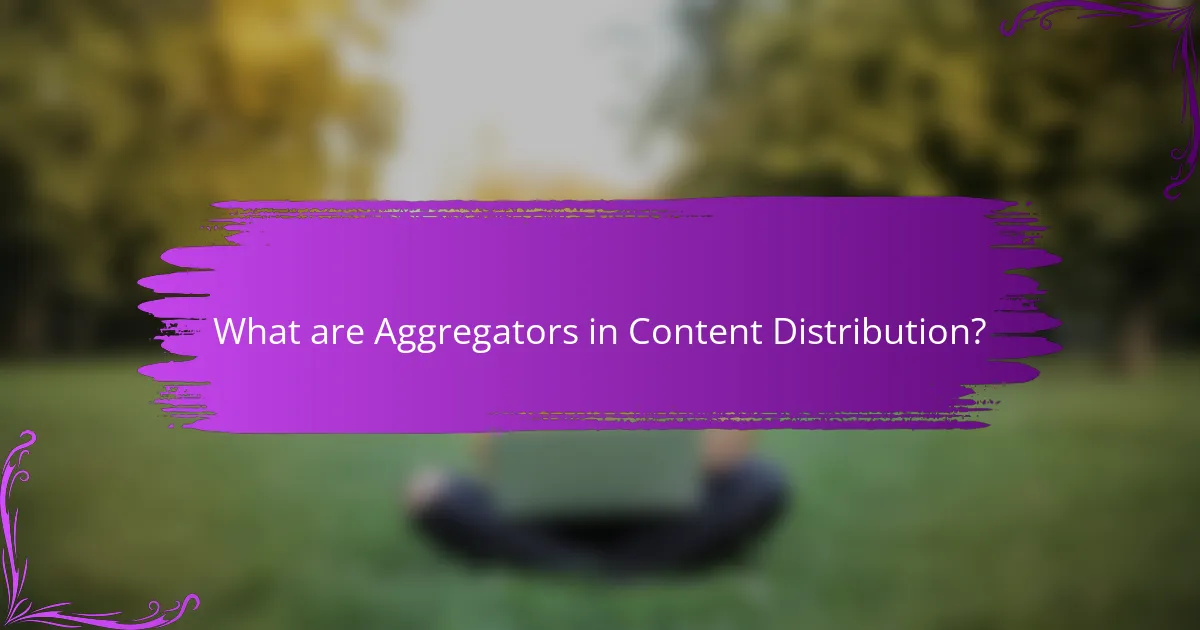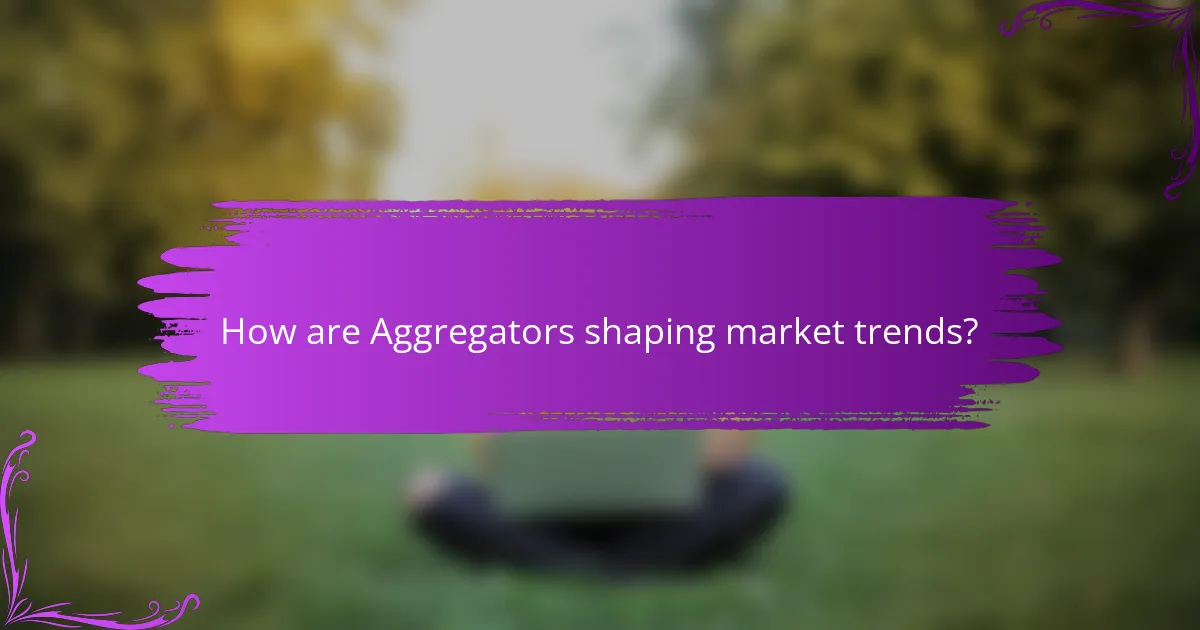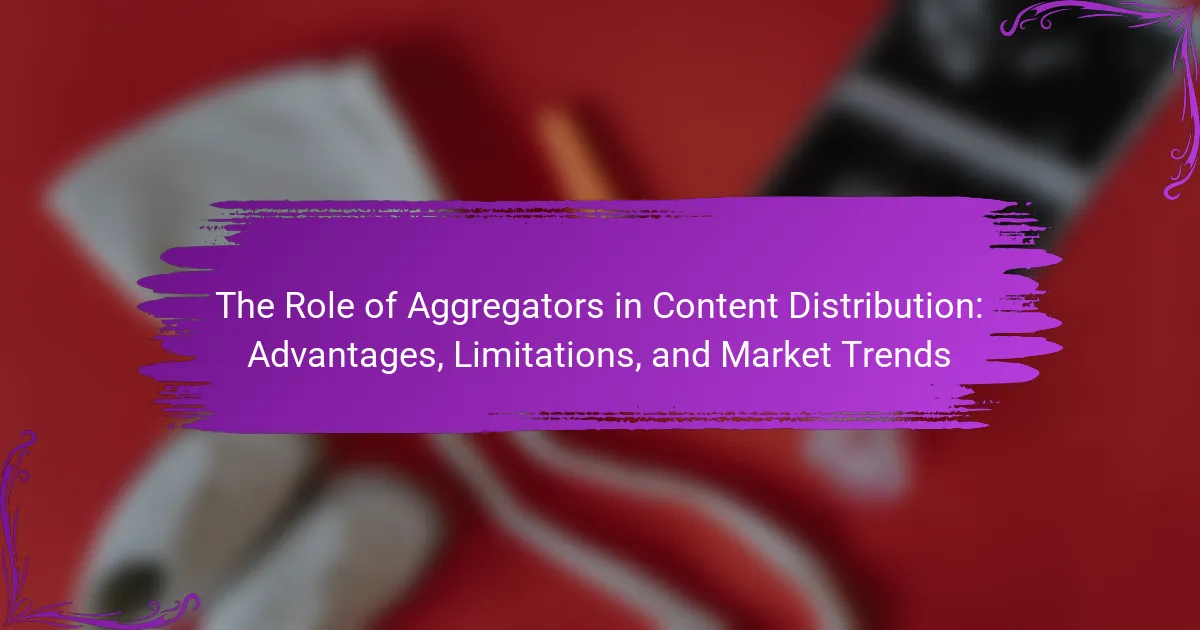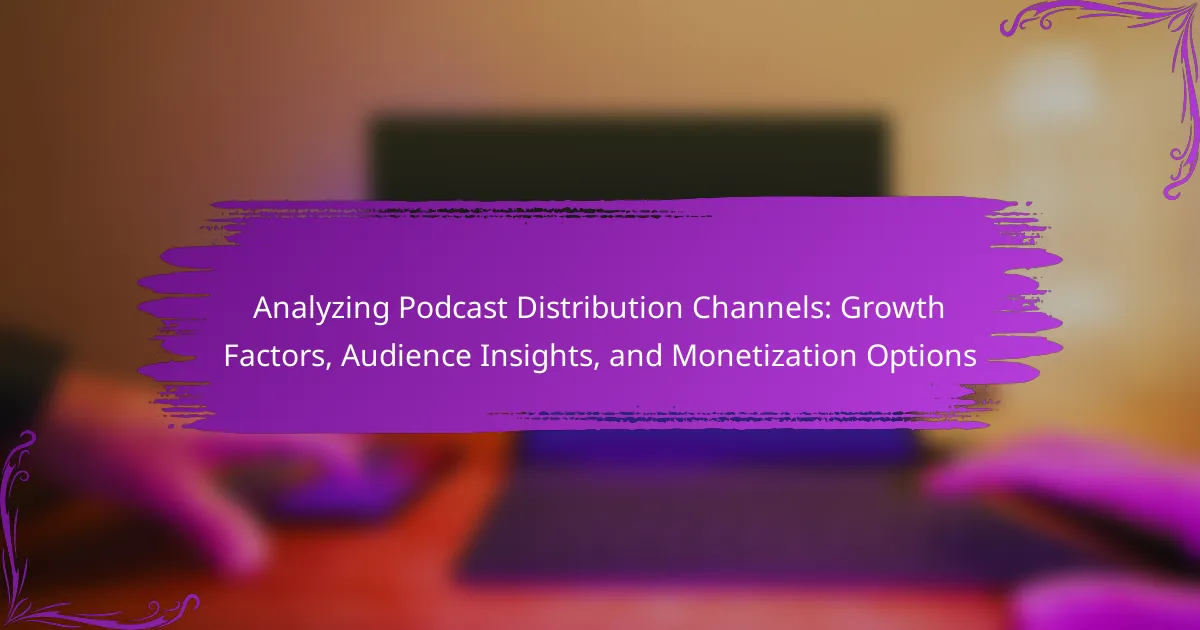
What are Aggregators in Content Distribution?
Aggregators in content distribution are platforms that collect and organize content from various sources. They enable users to access a wide range of information in one location. Aggregators can include news websites, social media platforms, and streaming services. They simplify content discovery by categorizing and presenting it based on user preferences. For example, Google News aggregates articles from multiple publishers. This allows users to stay informed without visiting each site individually. Aggregators often enhance user experience through personalized recommendations. They play a significant role in content consumption trends by shaping how audiences access information.
How do Aggregators function within the content ecosystem?
Aggregators function as intermediaries that collect and distribute content from various sources. They gather articles, videos, and other media types into a single platform. This process helps users access diverse content easily. Aggregators streamline content discovery for audiences by providing tailored feeds based on user interests. They often employ algorithms to curate and recommend content effectively. Major examples include news aggregators like Google News and content platforms like Feedly. These platforms enhance user engagement by presenting a wide range of topics in one place. Aggregators also provide analytics to content creators, helping them understand audience preferences.
What types of content do Aggregators typically distribute?
Aggregators typically distribute a variety of content types. This includes news articles, blog posts, videos, and podcasts. They also curate social media posts and user-generated content. Aggregators often focus on specific niches or industries, providing targeted information. For example, some may specialize in technology, while others cover entertainment or finance. The aim is to compile and present relevant content from multiple sources in one location. This helps users find information quickly and efficiently.
How do Aggregators source their content?
Aggregators source their content through various methods. They often utilize web scraping to collect data from multiple websites. This process allows them to gather articles, images, and videos automatically. Aggregators may also partner with content creators or publishers for direct access to their material. Some aggregators rely on user-generated content, encouraging submissions from individuals. Additionally, they may use APIs to pull content from other platforms in real-time. This multi-faceted approach enables aggregators to provide a diverse range of content to their audience.
What are the key advantages of using Aggregators?
Aggregators provide several key advantages in content distribution. They streamline access to diverse content from multiple sources. This saves users time by consolidating information in one location. Aggregators enhance content discovery through personalized recommendations. They often employ algorithms to tailor content to user preferences. Additionally, aggregators can increase visibility for content creators. They expose creators to broader audiences than they might reach independently. Cost efficiency is another advantage, as aggregators reduce marketing expenses for content distribution. According to a report by eMarketer, 60% of digital content consumers prefer using aggregators for their convenience.
How do Aggregators enhance content visibility?
Aggregators enhance content visibility by consolidating diverse content into a single platform. This aggregation allows users to discover a wider range of information quickly. By presenting content from various sources, aggregators increase the likelihood of user engagement. They often utilize algorithms to personalize content based on user preferences. This personalization further boosts visibility by making relevant content more accessible. Studies show that aggregated content can lead to higher traffic for original sources. For example, platforms like Google News or Feedly drive significant visitor numbers to publishers. Thus, aggregators play a crucial role in amplifying content reach and engagement.
What role do Aggregators play in audience engagement?
Aggregators play a crucial role in audience engagement by curating and consolidating content from multiple sources. They help users discover relevant information quickly. This increases user satisfaction and retention. Aggregators also facilitate interaction by allowing users to share content easily. They often provide personalized recommendations based on user preferences. This tailored experience enhances engagement levels. According to a study by the Pew Research Center, 62% of online adults use aggregators to find news. This statistic highlights the significance of aggregators in shaping audience engagement.
What limitations do Aggregators face in content distribution?
Aggregators face several limitations in content distribution. One key limitation is the reliance on third-party content. This dependence can lead to issues with copyright and licensing restrictions. Additionally, aggregators often struggle with content quality control. They may host a mix of high-quality and low-quality content, which can dilute user experience.
Another limitation is algorithmic bias. Aggregators use algorithms to curate content, which can inadvertently favor certain sources over others. This can lead to a lack of diversity in the content presented to users. Furthermore, aggregators may encounter challenges with audience engagement. Users might prefer original content from creators rather than aggregated summaries or links.
Lastly, aggregators often face competition from direct publishers. Many content creators choose to distribute their work directly, bypassing aggregators entirely. This shift can reduce the volume of content available to aggregators. Overall, these limitations hinder the effectiveness of aggregators in content distribution.
How do copyright issues affect Aggregators?
Copyright issues significantly impact aggregators by limiting their ability to distribute content legally. Aggregators often rely on third-party content to provide value to users. When copyright laws are violated, aggregators can face legal repercussions, including lawsuits or fines. For instance, unauthorized use of copyrighted material can result in takedown notices under the Digital Millennium Copyright Act (DMCA). This can disrupt service continuity and lead to loss of user trust. Additionally, copyright disputes may force aggregators to negotiate licensing agreements, which can be costly and time-consuming. The need for compliance with copyright regulations can also restrict the types of content aggregators can feature. Overall, copyright issues create operational challenges that can hinder the effectiveness of aggregators in the content distribution landscape.
What challenges do Aggregators encounter with content quality?
Aggregators encounter several challenges with content quality. One major challenge is the inconsistency of sources. Aggregators often pull content from various providers, leading to varying standards of quality. This inconsistency can result in misinformation or poorly curated content. Additionally, aggregators must contend with the issue of duplicate content. This can dilute the uniqueness of information presented to users. Another challenge is the lack of editorial oversight. Many aggregators do not have rigorous quality control processes in place. This absence can lead to the inclusion of subpar or irrelevant content. Furthermore, aggregators face the challenge of rapidly changing information. Keeping content updated to reflect the latest developments requires constant monitoring. Lastly, user-generated content can introduce quality variability. While it can enhance engagement, it may also compromise overall content integrity.

How are Aggregators shaping market trends?
Aggregators are significantly shaping market trends by centralizing content and streamlining access for consumers. They consolidate information from various sources, making it easier for users to find relevant content. This convenience drives consumer behavior towards platforms that offer comprehensive solutions. For instance, in the travel industry, aggregators like Expedia and Kayak allow users to compare prices across multiple airlines and hotels. This has led to increased competition among service providers, influencing pricing strategies. Additionally, aggregators often leverage data analytics to understand consumer preferences better. This insight enables them to tailor offerings and marketing strategies effectively. Overall, aggregators play a crucial role in transforming how markets operate and respond to consumer demands.
What recent trends are emerging in content aggregation?
Recent trends in content aggregation include increased personalization and the use of AI algorithms. Personalization allows users to receive tailored content based on their preferences. AI algorithms analyze user behavior to enhance content recommendations. Another trend is the rise of niche aggregators focusing on specific topics. These platforms cater to specialized audiences, improving user engagement. Additionally, mobile optimization is becoming essential as users increasingly access content via smartphones. Lastly, there is a growing emphasis on user-generated content. This trend encourages community involvement and enhances content diversity.
How are technological advancements influencing Aggregators?
Technological advancements are significantly influencing aggregators by enhancing their efficiency and effectiveness. Automation tools streamline content curation and distribution processes. Machine learning algorithms improve personalization for users, leading to better engagement. Advanced analytics provide insights into user behavior, allowing for targeted content strategies. Cloud computing facilitates scalability, enabling aggregators to handle larger volumes of data and content. APIs allow seamless integration with various platforms, expanding reach and functionality. Mobile technology ensures accessibility, allowing users to access content anytime and anywhere. These advancements collectively empower aggregators to deliver more relevant and timely content to their audiences.
What shifts are occurring in consumer behavior towards Aggregators?
Consumers are increasingly favoring aggregators for their convenience and efficiency. This shift is driven by the desire for streamlined access to diverse content in one place. Users appreciate the time-saving aspect of aggregators, which consolidate information from multiple sources. Data shows that over 70% of consumers prefer using a single platform to access various services. Additionally, mobile usage is rising, with over 50% of users accessing aggregators via smartphones. This trend reflects a growing reliance on digital solutions for everyday tasks. As a result, aggregators are adapting to meet user demands by enhancing user experience and personalization features.
How do Aggregators compare with traditional content distribution methods?
Aggregators streamline content distribution more efficiently than traditional methods. They consolidate various sources into a single platform. This reduces the time users spend searching for content. Traditional methods often require users to visit multiple sites. Aggregators also provide personalized content recommendations. This enhances user engagement compared to generic offerings from traditional methods. According to a 2021 report by Statista, 70% of users prefer using aggregators for content discovery. Additionally, aggregators often utilize algorithms to optimize content delivery. This targeted approach contrasts with the broad reach of traditional distribution.
What advantages do Aggregators offer over traditional methods?
Aggregators provide several advantages over traditional methods of content distribution. They streamline access to diverse content from multiple sources in one platform. This centralization saves time for users seeking specific information. Aggregators often utilize algorithms to personalize content recommendations, enhancing user engagement. They also enable real-time updates, ensuring users receive the latest information promptly. Additionally, aggregators typically reduce costs for content creators by offering wider reach without extensive marketing efforts. According to a 2021 study by Pew Research, 71% of users prefer aggregators for their convenience and variety. These factors collectively make aggregators a more efficient option compared to traditional distribution methods.
In what ways are traditional methods adapting to compete with Aggregators?
Traditional methods are adapting by enhancing their online presence and leveraging technology. They are investing in digital marketing strategies to reach broader audiences. Traditional businesses are also forming partnerships with technology firms to improve service delivery. They are focusing on personalized customer experiences to build loyalty. Additionally, they are utilizing data analytics to understand consumer behavior better. Many are diversifying their offerings to include digital products or services. Traditional methods are also adopting subscription models to create recurring revenue streams. These adaptations are necessary to remain competitive against aggregators in the evolving market landscape.

What are the future prospects for Aggregators in content distribution?
Aggregators in content distribution are likely to see continued growth and evolution. As digital content consumption increases, aggregators will play a crucial role in curating and delivering diverse content. The rise of personalized content consumption trends will further enhance their relevance. Additionally, advancements in AI and machine learning will improve content recommendation algorithms. According to a report by Statista, the global content aggregation market is expected to grow significantly, indicating strong demand. Furthermore, partnerships between aggregators and content creators will likely strengthen, leading to innovative distribution models. Overall, the future looks promising for aggregators in the content distribution landscape.
How might Aggregators evolve in response to market demands?
Aggregators may evolve by enhancing personalization and user experience. They are increasingly using AI algorithms to analyze user behavior. This allows for tailored content recommendations. Additionally, aggregators may expand their service offerings. They could include features such as subscription models or exclusive content access. Market demands for real-time information may prompt aggregators to improve update frequencies. Enhanced mobile compatibility will likely be a focus due to rising mobile usage. Collaborations with content creators can also strengthen their market position. This evolution aligns with the growing consumer preference for curated content experiences.
What innovations are expected in the Aggregator space?
Innovations in the aggregator space are expected to include enhanced AI-driven personalization features. These advancements will allow aggregators to curate content more effectively based on user preferences. Additionally, improved data analytics tools will enable better insights into user behavior. This will facilitate targeted marketing strategies for content creators. Another anticipated innovation is the integration of blockchain technology for more transparent content distribution. This could enhance trust between content creators and consumers. Furthermore, there is a trend towards mobile-first aggregator platforms to accommodate increasing mobile usage. These innovations are likely to reshape how content is distributed and consumed.
How can Aggregators improve their services to meet user needs?
Aggregators can improve their services by enhancing user personalization and streamlining content access. They can implement advanced algorithms to analyze user preferences. This allows for tailored recommendations that align with individual interests. Additionally, improving user interface design can facilitate easier navigation. A streamlined experience encourages users to engage more with the content. Aggregators can also enhance their partnerships with content providers. This ensures a wider variety of quality content is available. Regularly updating their offerings keeps users engaged and satisfied. User feedback mechanisms can help identify areas for improvement. By actively responding to user needs, aggregators can foster loyalty and increase usage.
What best practices should content creators follow when using Aggregators?
Content creators should ensure they provide original content when using aggregators. Originality helps maintain credibility and avoids copyright issues. They should also optimize content for SEO to improve visibility on aggregator platforms. This includes using relevant keywords and engaging headlines. Additionally, creators must engage with their audience through comments and feedback. This interaction fosters community and encourages sharing. Regularly updating content is also essential to keep it relevant and fresh. Lastly, creators should analyze performance metrics to understand what works best. This data-driven approach enhances future content strategies.
How can content creators effectively leverage Aggregators for distribution?
Content creators can effectively leverage aggregators for distribution by strategically selecting platforms that align with their target audience. They should optimize their content for each aggregator’s format and guidelines. This includes using appropriate tags, descriptions, and images to enhance visibility. Creators can also engage with the community on these platforms to build relationships and increase reach. Additionally, analyzing performance metrics from aggregators helps refine future content strategies. According to a study by the Content Marketing Institute, 70% of marketers found that using content aggregators improved their content’s reach and engagement.
Aggregators in content distribution are platforms that compile and organize content from diverse sources, enabling users to access a wide range of information efficiently. This article explores the functionality of aggregators within the content ecosystem, the types of content they distribute, and how they source this information. It also examines the advantages they offer, such as streamlined access and enhanced visibility for content creators, while addressing limitations like copyright issues and content quality challenges. Additionally, the article highlights emerging trends in aggregation, technological advancements, and the evolving consumer behavior towards these platforms, providing a comprehensive overview of the role of aggregators in shaping market trends.



